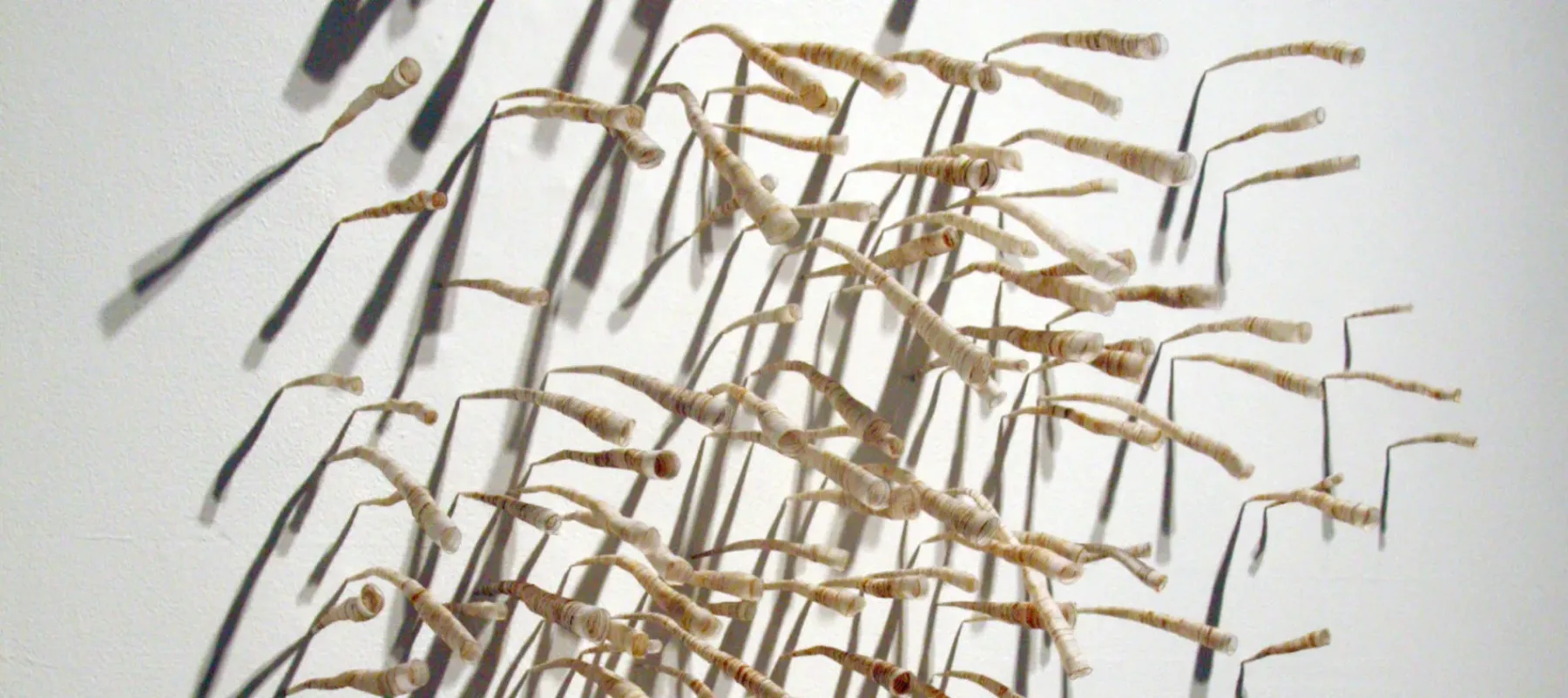WASHINGTON—The third installment in the National Museum of Women in the Arts’ (NMWA) Women to Watch exhibition series examines innovative approaches to a traditional medium: fiber. High Fiber—Women to Watch 2012 features work by seven emerging artists from the U.S., the U.K. and France. The exhibition is on view November 2, 2012–January 6, 2013.
NMWA’s biennial exhibition series Women to Watch features up-and-coming or underrepresented artists from the states and countries in which the museum has outreach committees. The committees consulted with contemporary art curators in their respective regions to create shortlists of artists who specialize in this year’s theme—inventive use of fibers. NMWA then selected the artists and their respective works.
NMWA Chief Curator Kathryn A. Wat commented, “The Women to Watch series explores global trends in art but at the local or micro level. Some artists featured in the exhibition work in the world’s biggest cities and art markets, while others create within vibrant smaller communities. Women to Watch highlights the boundless variety of experiences that inspire women artists today.”
Women to Watch 2012 Artists and Nominating Committees
Ligia Bouton (b. 1973, New Mexico Committee) Bouton’s six-foot-cube satin bouquet is alluring both for its lush materials and scale. Six Photographs of People I Don’t Know: Photograph 5, The Bouquet (2007) was inspired by a vintage wedding photograph Bouton found of a young couple. Creating the bouquet at a large scale and suspending it from the gallery ceiling, Bouton presents her dreamy reimagining of the event.
Louise Halsey (b. 1949, Arkansas Committee) presents narrative images in textile panels, creating modern-day iterations of classical tapestries. Houses in Halsey’s tapestries are sometimes topped by columns of smoke or veiled by flame-like shapes that signify ongoing threats to the environment and humankind. Her Supersize My House (2011), in which a mansion looms above a modest house, is both humorous and sobering.
Debra Folz (b. 1979, Massachusetts Committee) cross-stitches into her machine-made chairs and tables, and she wraps shelving and stools with knitted cozies or pleated fabric. She eschews “assigned material identities,” applying and combining materials in unexpected ways to expand their meaning. Folz creates a pun in Sight (2011), a mirror cross-stitched with the form of a gun sight’s crosshairs. Anyone trying to use the mirror must dodge around to get even a partial view.
Tracy Krumm (b. 1963, Greater Kansas City Area Committee) crochets fine-gauge wire into organically-shaped pods or broad panels resembling domestic textiles. Her cheekily titled Yoke/Folded (2006) and Draped (Screwed) (2010) might be a blanket or billowing curtain, respectively. Krumm’s works blur distinctions between visual—and cultural—categories. Suspended from steel and wood armatures and moving just slightly with a breeze, Krumm’s quasi-textiles appear simultaneously feminine and masculine, scientific and historical, hard and soft, and heavy and light.
Beili Liu (b. 1974, Texas Committee) “plays” with materials (including paper, wicker, cloth, and thread), letting their inherent properties guide her creative process. To create Toil (2008), Liu trimmed the edges of thin strips of silk organza with a lit incense cone. She then coiled the fabric into cones that twist and curve. Liu’s meticulous handwork transfers energy to each element, resulting in an array of animated forms sprouting from the gallery wall surface.
Rachael Matthews (b. 1974, Friends of NMWA, UK) created The Knitted Wedding (2005) with other members of a knitting club she co-founded. They stitched nearly every accessory for a marriage ceremony. Knitted altar candles and reception hors d’oeuvres complimented the bridal couple’s attire. Matthews’ installation A Meeting Place for a Sacrifice to the Ultimate Plan (2010-12) combines many enigmatic knitted objects, including a skull and crossbones and an hourglass.
Laure Tixier (b. 1972, Les Amis du NMWA) explores domestic architecture. She compares her recent house sculptures made from felt to blanket forts built by children. Her eight-foot-tall Plaid House (2008) resembles the classic architecture of Amsterdam and reflects her interest in architectural history. Tixier’s smaller felt constructions are variations on architectural designs from cultures worldwide. Her vividly colored “maquettes” resemble yurts, bell towers, office buildings, or space-age pods.
High Fiber—Women to Watch 2012 is organized by the National Museum of Women in the Arts and is generously sponsored by the participating committees with assistance from Guerlain and the Louis J. Kuriansky Foundation, Inc. Additional support for Les Amis du NMWA is provided by Katherine Graham Debost and Air France.
# # #
National Museum of Women in the Arts
Founded in 1981 and opened in 1987, NMWA is the only museum solely dedicated to celebrating the achievements of women in the visual, performing and literary arts. The museum’s collection features 4,000 works from the 16th century to the present created by more than 1,000 artists; including Mary Cassatt, Frida Kahlo, Alma Thomas, Lee Krasner, Louise Bourgeois, Chakaia Booker, and Nan Goldin along with special collections of 18th-century silver tableware and botanical prints. NMWA is located at 1250 New York Avenue, NW, Washington, D.C., in a landmark building near the White House. It is open Monday–Saturday, 10 a.m.–5 p.m. and Sunday, noon–5 p.m. For information, call 202-783-5000 or visit www.nmwa.org. Admission is $10 for adults, $8 for visitors 65 and over and students, and free for NMWA Members and youth 18 and under.

